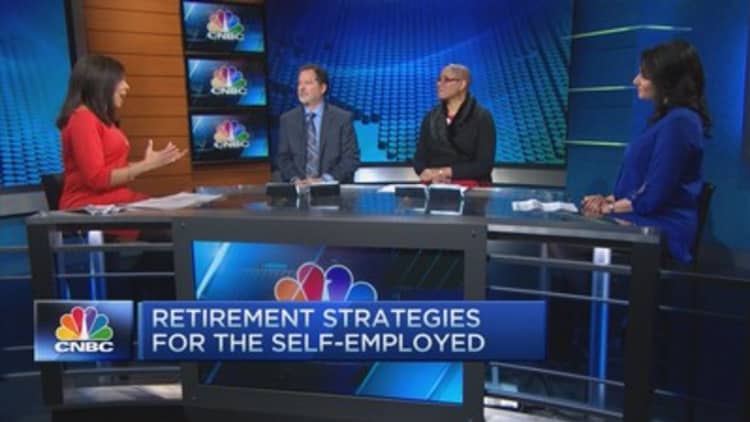
At the end of a long career, most corporate employees can expect some sort of sendoff—perhaps a Costco sheet cake in the conference room as their colleagues gather around for several rounds of "For (S)He's a Jolly Good Fellow."
When you call yourself boss, though, retiring is a lonelier affair, as is saving for retirement.
Of the almost 15 million Americans who are self-employed, 28 percent don't save for retirement at all, compared to just 10 percent of people who are working in traditional jobs, according to a TDAmeritrade survey.
"It's the nature of entrepreneurs to think they'll never retire or they'll sell their business and that will be their retirement plan," said CPA Lisa Featherngill, a certified financial planner and managing director with Abbot Downing.
You might need less lofty retirement-planning expectations.
Read MoreHelp arrives for female entrepreneurs
The good news is that there are lots of options. The bad news is that none of them offer an employer match or even a glossy brochure explaining it all to you.
Everything is up to you.
"You have to do all the work of an employee and an employer," said Andrew Meadows, consumer and brand ambassador of Ubiquity Retirement + Savings, an Internet-based flat-fee-for-service retirement plan provider for small-business owners.
The challenge is wading through all the retirement plan options and deciding which one is right for you.
"Actually, self-employed individuals have a lot of choices around retirement and can often save more than employed people," Featherngill said.
If you're self-employed and have no employees, I really like the solo [IRA] because it's flexible.Alex Mojicawealth management strategist with Zions Bancorporation
The good ol' IRA
If you're just starting out on your self-employed journey and still not earning much, don't overlook an individual retirement account. IRAs are available in traditional and Roth versions.
The traditional, tax-deductible version allows you to deduct all your contributions from your current year's income, possibly lowering your tax bracket. You will owe income taxes on withdrawals after age 59½. Withdrawals prior to that age incur income tax plus a 10 percent penalty.
Roth IRAs allow you to contribute the same amount, but with after-tax money. No tax is owed on withdrawals. You can withdraw any of your contribution tax-free since you've already paid the tax prior to 59½, but not earnings.
In 2015 the maximum you can contribute is $5,500 (those 50 and older can kick in an additional $1,000).
You can make your contributions for the previous year as late as October of this year if you file for an extension of your taxes.
While IRAs are a good start, you'll need something more powerful if you hope to have a sizable retirement kitty. Financial experts recommend contributions of 10 percent to 15 percent of your salary, and in many cases the small contribution limits of an IRA won't get you there.
The SIMPLE way out
If your company has fewer than 100 employees, you can set up a Savings Investment Match Plan for Employees. The contribution limits are higher than an IRA—$12,500, plus an additional $3,000 if you're over 50.
"It's basically an IRA that's turbo-charged," Featherngill said. "And it's really easy to set up."
Read MoreDon't make Uncle Sam your heir
Because it's an employer plan, if you take this route for yourself, you're obligated to contribute for any employees, too. SIMPLE IRAs require an employer to make contributions of 3 percent of salary on behalf of employees, regardless of whether the employee makes a contribution.
Like other IRAs, you pay a penalty of 10 percent for taking your money out before age 59½. The SIMPLE IRA takes it up a notch. Any distributions from the account within two years of setting it up incur a 25 percent penalty.
SEP this way
Like other IRAs, Simplified Employee Pension (SEP) IRAs are easy to set up and fund. They have more generous contribution limits, up to $53,000 or 25 percent of your profit, whichever is less. (If you are unincorporated, only 20 percent is allowable.) You can even contribute to a SEP if you have a traditional job and are covered by a workplace plan but still have self-employed income.
"It's very low cost to maintain, and you can scale it up depending on how much profit you have," said CPA Armando Roman, a financial planner and wealth manager with Axiom Financial Advisory Group.
Like an IRA, you may fund the plan up to Oct. 15 for the previous year if you file an extension for your taxes.
If you have employees, however, you must fund their retirement accounts at the same percentage as your own contribution—so no giving yourself a bigger cut.
Going solo
The individual or solo 401(k) plan lets you sock away much greater amounts for retirement at a smaller salary base. It has two parts: One is the employee salary deferral. The other is an employer profit-sharing contribution. Since self-employed people are both employer and employee, they're eligible for both parts.
In 2015 you can park up to $18,000 (plus $6,000 if you're 50 and older) in addition to 20 percent of your compensation, up to a total limit of $53,000 (or $59,000 if you're over 50).
Let's say you earn $150,000 and are over 50. You can contribute $24,000 through the salary deferral portion. Then you can set aside 20 percent (or 25 percent if you are incorporated) of your salary minus your 401(k) contributions and self-employment tax, which amounts to about $8,900. In this example, you would be able to contribute a total of about $47,000.
Read MoreAvoiding dumb retirement mistakes
"If you're self-employed and have no employees, I really like the solo [IRA] because it's flexible," said Alex Mojica, a wealth management strategist with Zions Bancorporation.
What's more, solo 401(k) plans have loan provisions if your plan provider allows them. "It's never advised to take a loan from your 401(k), because it can hamper the growth [of your money,]" Mojica said. "But it might provide someone with peace of mind that they can access their money if they need it."
Like other 401(k) plans, the solo versions are governed by the Department of Labor, so there's more paperwork in setting them up and more oversight, said Meadows of Ubiquity.
"All that compliance is your responsibility," he said.
—By Ilana Polyak, special to CNBC.com




